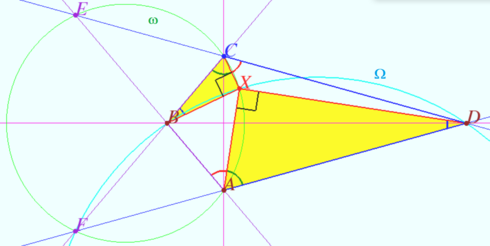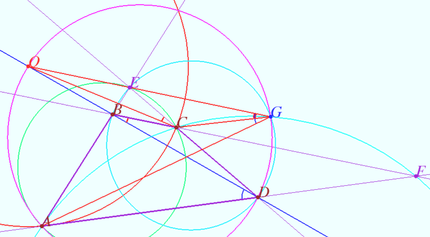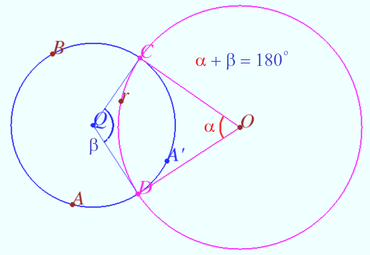Difference between revisions of "2018 IMO Problems/Problem 6"
(→Solution) |
(→Solution) |
||
| Line 6: | Line 6: | ||
==Solution== | ==Solution== | ||
[[File:2018 IMO 6.png|490px|right]] | [[File:2018 IMO 6.png|490px|right]] | ||
| + | Suppose point X is unique. We will construct point <math>X_0</math> and prove that <math>X_0</math> coincides with the point <math>X.</math> | ||
<i><b>Special case</b></i> | <i><b>Special case</b></i> | ||
| − | |||
| − | |||
Let <math>AD = CD</math> and <math>AB = BC \implies AB \cdot CD = BC \cdot DA.</math> | Let <math>AD = CD</math> and <math>AB = BC \implies AB \cdot CD = BC \cdot DA.</math> | ||
| Line 22: | Line 21: | ||
Quadrilateral <math>AX_0CF</math> is cyclic <math>\implies</math> <cmath>\angle X_0AB = \frac {\overset{\Large\frown} {X_0CE}}{2} = \frac {360^\circ -\overset{\Large\frown} {X_0AFE}}{2} = 180^\circ - \angle X_0CE = \angle X_0CD.</cmath> | Quadrilateral <math>AX_0CF</math> is cyclic <math>\implies</math> <cmath>\angle X_0AB = \frac {\overset{\Large\frown} {X_0CE}}{2} = \frac {360^\circ -\overset{\Large\frown} {X_0AFE}}{2} = 180^\circ - \angle X_0CE = \angle X_0CD.</cmath> | ||
| − | Similarly, quadrangle <math>DX_0BF</math> is cyclic <math>\implies \angle X_0BC = \angle X_0DA</math>. | + | Similarly, quadrangle <math>DX_0BF</math> is cyclic <math>\implies \angle X_0BC = \angle X_0DA</math>. This means that point <math>X_0</math> coincides with the point <math>X</math>. |
| − | |||
| − | This means that point <math>X_0</math> coincides with the point <math>X</math>. | ||
| − | |||
| − | |||
| − | <math>\hspace{10mm} \angle | + | <math>\hspace{10mm} \angle FCX = \angle BCX = \frac {\overset{\Large\frown} {XAF}}{2}</math> of <math>\omega.</math> <math>\hspace{10mm} \angle CBX = \angle XDA = \frac {\overset{\Large\frown} {XBF}}{2}</math> of <math>\Omega.</math> |
| − | |||
| − | |||
| + | The sum <math>\overset{\Large\frown} {XAF} + \overset{\Large\frown} {XBF} = 180^\circ</math> <i><b>(Claim 3)</b></i> <math>\implies</math> | ||
<math>\angle XCB + \angle XBC = 90^\circ \implies \angle CXB = 90^\circ.</math> | <math>\angle XCB + \angle XBC = 90^\circ \implies \angle CXB = 90^\circ.</math> | ||
| Line 43: | Line 37: | ||
<i><b>Common case </b></i> | <i><b>Common case </b></i> | ||
| − | Denote by <math>O</math> the intersection point | + | Denote by <math>O</math> the intersection point of <math>BD</math> and the perpendicular bisector of <math>AC.</math> Let <math>\omega</math> be a circle (red) with center <math>O</math> and radius <math>OA.</math> |
The points <math>B</math> and <math>D</math> are symmetric with respect to the circle <math>\omega</math> <i><b>(Claim 1).</b></i> | The points <math>B</math> and <math>D</math> are symmetric with respect to the circle <math>\omega</math> <i><b>(Claim 1).</b></i> | ||
| Line 55: | Line 49: | ||
Similarly, quadrangle <math>AX_0CE</math> is cyclic <math>\implies \angle X_0AB = \angle X_0CD = \alpha.</math> | Similarly, quadrangle <math>AX_0CE</math> is cyclic <math>\implies \angle X_0AB = \angle X_0CD = \alpha.</math> | ||
| − | + | This means that point <math>X_0</math> coincides with the point <math>X</math>. | |
Denote by <math>Y</math> the point of intersection of circles <math>BDF</math> and <math>ACF.</math> | Denote by <math>Y</math> the point of intersection of circles <math>BDF</math> and <math>ACF.</math> | ||
Revision as of 11:54, 21 August 2022
A convex quadrilateral ![]() satisfies
satisfies ![]() Point
Point ![]() lies inside
lies inside
![]() so that
so that
![]() and
and ![]() Prove that
Prove that ![]()
Solution
Suppose point X is unique. We will construct point ![]() and prove that
and prove that ![]() coincides with the point
coincides with the point ![]()
Special case
Let ![]() and
and ![]()
Let ![]() and
and ![]() be the intersection points of
be the intersection points of ![]() and
and ![]() and
and ![]() and
and ![]() respectively.
respectively.
The points ![]() and
and ![]() are symmetric with respect to the circle
are symmetric with respect to the circle ![]() (Claim 1).
(Claim 1).
The circle ![]() is orthogonal to the circle
is orthogonal to the circle ![]() (Claim 2).
(Claim 2).
Let ![]() be the point of intersection of the circles
be the point of intersection of the circles ![]() and
and ![]() Quadrilateral
Quadrilateral ![]() is cyclic
is cyclic ![]()
![]()
Similarly, quadrangle ![]() is cyclic
is cyclic ![]() . This means that point
. This means that point ![]() coincides with the point
coincides with the point ![]() .
.
![]() of
of ![]()
![]() of
of ![]()
The sum ![]() (Claim 3)
(Claim 3) ![]()
![]()
Similarly, ![]()
Common case
Denote by ![]() the intersection point of
the intersection point of ![]() and the perpendicular bisector of
and the perpendicular bisector of ![]() Let
Let ![]() be a circle (red) with center
be a circle (red) with center ![]() and radius
and radius ![]()
The points ![]() and
and ![]() are symmetric with respect to the circle
are symmetric with respect to the circle ![]() (Claim 1).
(Claim 1).
The circles ![]() and
and ![]() are orthogonal to the circle
are orthogonal to the circle ![]() (Claim 2).
(Claim 2).
Circles ![]() and
and ![]() are symmetric with respect to the circle
are symmetric with respect to the circle ![]() (Lemma).
(Lemma).
Denote by ![]() the point of intersection of the circles
the point of intersection of the circles ![]() and
and ![]() Quadrangle
Quadrangle ![]() is cyclic
is cyclic ![]() (see Special case).
Similarly, quadrangle
(see Special case).
Similarly, quadrangle ![]() is cyclic
is cyclic ![]()
This means that point ![]() coincides with the point
coincides with the point ![]() .
.
Denote by ![]() the point of intersection of circles
the point of intersection of circles ![]() and
and ![]()
Quadrangle ![]() is cyclic
is cyclic ![]()
Quadrangle ![]() is cyclic
is cyclic ![]()
The triangles ![]() by two angles, so
by two angles, so ![]()
The points ![]() and
and ![]() are symmetric with respect to the circle
are symmetric with respect to the circle ![]() , since they lie on the intersection of the circles
, since they lie on the intersection of the circles ![]() and
and ![]() symmetric with respect to
symmetric with respect to ![]() and the circle
and the circle ![]() orthogonal to
orthogonal to ![]()
The point ![]() is symmetric to itself, the point
is symmetric to itself, the point ![]() is symmetric to
is symmetric to ![]() with respect to
with respect to ![]() Usung
Usung ![]() and the equality
and the equality ![]() we get
we get ![]() The point
The point ![]() is symmetric to itself, the point
is symmetric to itself, the point ![]() is symmetric to
is symmetric to ![]() with respect to
with respect to ![]()
![]()
![]() The point
The point ![]() is symmetric to
is symmetric to ![]() and the point
and the point ![]() is symmetric to
is symmetric to ![]() with respect to
with respect to ![]() hence
hence
![]()
![]() Denote
Denote ![]()
By the law of sines for ![]() we obtain
we obtain ![]()
By the law of sines for ![]() we obtain
we obtain ![]()
We make transformation and get ![]() If
If ![]() then
then ![]()
![]() Given that
Given that ![]() This is a special case.
This is a special case.
In all other cases, the equality of the sines follows ![]()
Claim 1 Let ![]() and
and ![]() be arbitrary points on a circle
be arbitrary points on a circle ![]() be the perpendicular bisector to the segment
be the perpendicular bisector to the segment ![]() Then the straight lines
Then the straight lines ![]() and
and ![]() intersect
intersect ![]() at the points
at the points ![]() and
and ![]() symmetric with respect to
symmetric with respect to ![]()
Claim 2 Let points ![]() and
and ![]() be symmetric with respect to the circle
be symmetric with respect to the circle ![]() Then any circle
Then any circle ![]() passing through these points is orthogonal to
passing through these points is orthogonal to ![]()
Claim 3 The sum of the arcs between the points of intersection of two perpendicular circles is ![]() In the figure they are a blue and red arcs
In the figure they are a blue and red arcs ![]()
Lemma The opposite sides of the quadrilateral ![]() intersect at points
intersect at points ![]() and
and ![]() (
(![]() lies on
lies on ![]() ). The circle
). The circle ![]() centered at the point
centered at the point ![]() contains the ends of the diagonal
contains the ends of the diagonal ![]() The points
The points ![]() and
and ![]() are symmetric with respect to the circle
are symmetric with respect to the circle ![]() (in other words, the inversion with respect to
(in other words, the inversion with respect to ![]() maps
maps ![]() into
into ![]() Then the circles
Then the circles ![]() and
and ![]() are symmetric with respect to
are symmetric with respect to ![]()
Proof We will prove that the point ![]() symmetric to the point
symmetric to the point ![]() with respect to
with respect to ![]() belongs to the circle
belongs to the circle ![]() For this, we will prove the equality
For this, we will prove the equality ![]()
A circle ![]() containing points
containing points ![]() and
and ![]() symmetric with respect to
symmetric with respect to ![]() is orthogonal to
is orthogonal to ![]() (Claim 2) and maps into itself under inversion with respect to the circle
(Claim 2) and maps into itself under inversion with respect to the circle ![]() Hence, the point
Hence, the point ![]() under this inversion passes to some point
under this inversion passes to some point ![]() of the same circle
of the same circle ![]()
A straight line ![]() containing the point
containing the point ![]() of the circle
of the circle ![]() under inversion with respect to
under inversion with respect to ![]() maps into the circle
maps into the circle ![]() Hence, the inscribed angles of this circle are equal
Hence, the inscribed angles of this circle are equal ![]()
![]() maps into
maps into ![]() and
and ![]() maps into
maps into ![]() Consequently, the angles
Consequently, the angles ![]() \angle CGE =
\angle CGE = ![]() These angles subtend the
These angles subtend the ![]() of the
of the ![]() circle, that is, the point
circle, that is, the point ![]() symmetric to the point
symmetric to the point ![]() with respect to
with respect to ![]() belongs to the circle
belongs to the circle ![]()















